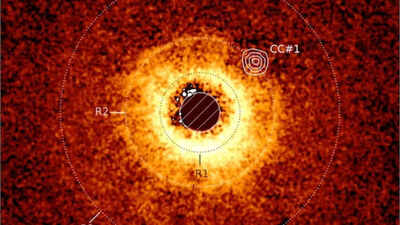The James Webb Space Telescope has achieved a milestone, directly imaging a newly discovered planet, TWA 7b, after three years of aiding astronomers in exoplanet research. This marks the telescope's first confirmed planetary discovery.

Image: Artist's rendering of the exoplanet TWA 7b as seen by the James Webb Space Telescope.
TWA 7b is a young planet with a mass only 0.3 times that of Jupiter (approximately 100 times Earth's mass), making it the lowest-mass planet ever directly imaged outside of our solar system. It is ten times lighter than any exoplanet previously photographed.
This exoplanet orbits CE Antliae (TWA 7), a young, low-mass star about 111 light-years away in the Antlia constellation. Discovered in 1999, CE Antliae belongs to the TW Hydrae Association, a youthful group of stars. At roughly 6.4 million years old, CE Antliae is a cosmic infant compared to our Sun. Its youth and orientation made it perfect for JWST imaging.
Infrared imaging was crucial in discovering TWA 7b. Young, low-mass planets emit thermal radiation in the infrared spectrum, which JWST is designed to detect. The telescope’s Mid-Infrared Instrument (MIRI) and a coronagraph were essential to the discovery.
A coronagraph blocks the overwhelming light from a star, enabling the detection of faint nearby objects like exoplanets. The JWST team employed high-contrast imaging to find a faint infrared source within the debris disc surrounding TWA 7.
This source was located in a gap between dust rings, a region where a planet's gravity is theorized to clear out material. Simulations confirmed that a planet with the mass of Saturn in that location could explain the observed structure.
The disc around TWA 7 features three distinct rings with gaps. One gap contains a narrow ring flanked by dust-free regions, a common sign of a planet's gravitational influence. The infrared glow detected by JWST precisely matches this ring gap. Its brightness, temperature (around 320 Kelvin or 47°C), and orbital distance (approximately 50 astronomical units from the star) align with expectations for a planet in this region.
The discovery of TWA 7b is significant for several reasons:
Astronomers believe that debris discs around young stars serve as blueprints for planetary formation. These rings and gaps show where material accumulates to form planets or is cleared by their gravity. TWA 7b may be the first direct evidence of this process.
Researchers used advanced image subtraction methods to detect TWA 7b. By removing residual starlight, they isolated the planet from other celestial objects. This discovery showcases how new observing methods and instruments on JWST, such as the coronagraph and MIRI, are expanding our ability to discover previously inaccessible exoplanets. JWST's mid-infrared sensitivity now allows it to detect planets as massive and cold as Saturn.
JWST's ability to suppress starlight and detect faint heat signatures of small, cold planets opens a new era in exoplanet discovery. Astronomers are optimistic that even lighter planets, potentially Neptune-mass or super-Earths, could soon be within reach.
Future observations will focus on:
Newer articles
 5 Overlooked Warning Signs of Colon Cancer: Early Detection Saves Lives
5 Overlooked Warning Signs of Colon Cancer: Early Detection Saves Lives
 Shukla's ISS Arrival Heralds New Era for Indian Space Exploration; Gaganyaan Mission Looms
Shukla's ISS Arrival Heralds New Era for Indian Space Exploration; Gaganyaan Mission Looms
 Vijay Sethupathi Apologizes Amid Controversy Over Son Surya's Film 'Phoenix'; Thalapathy Vijay's Support Revealed
Vijay Sethupathi Apologizes Amid Controversy Over Son Surya's Film 'Phoenix'; Thalapathy Vijay's Support Revealed
 Android Security Alert: Government Warns of Critical Flaws Exposing User Data
Android Security Alert: Government Warns of Critical Flaws Exposing User Data
 Ashada Gupt Navratri 2025: Dates, Significance, and How to Observe This Hidden Festival
Ashada Gupt Navratri 2025: Dates, Significance, and How to Observe This Hidden Festival
 Skin Deep: 7 Warning Signs on Your Skin That Could Signal Heart Trouble
Skin Deep: 7 Warning Signs on Your Skin That Could Signal Heart Trouble
 Smith Eyes Grenada Test Return After Injury Layoff
Smith Eyes Grenada Test Return After Injury Layoff
 Staying Hydrated May Significantly Lower Risk of Heart Failure, New Study Suggests
Staying Hydrated May Significantly Lower Risk of Heart Failure, New Study Suggests
 Moto G54 Price Slashed in India: Check Out the New, Lowered Costs
Moto G54 Price Slashed in India: Check Out the New, Lowered Costs
 Gambhir Sidelines Pant's Twin Tons After India's Test Loss, Emphasizes Team Performance
Gambhir Sidelines Pant's Twin Tons After India's Test Loss, Emphasizes Team Performance